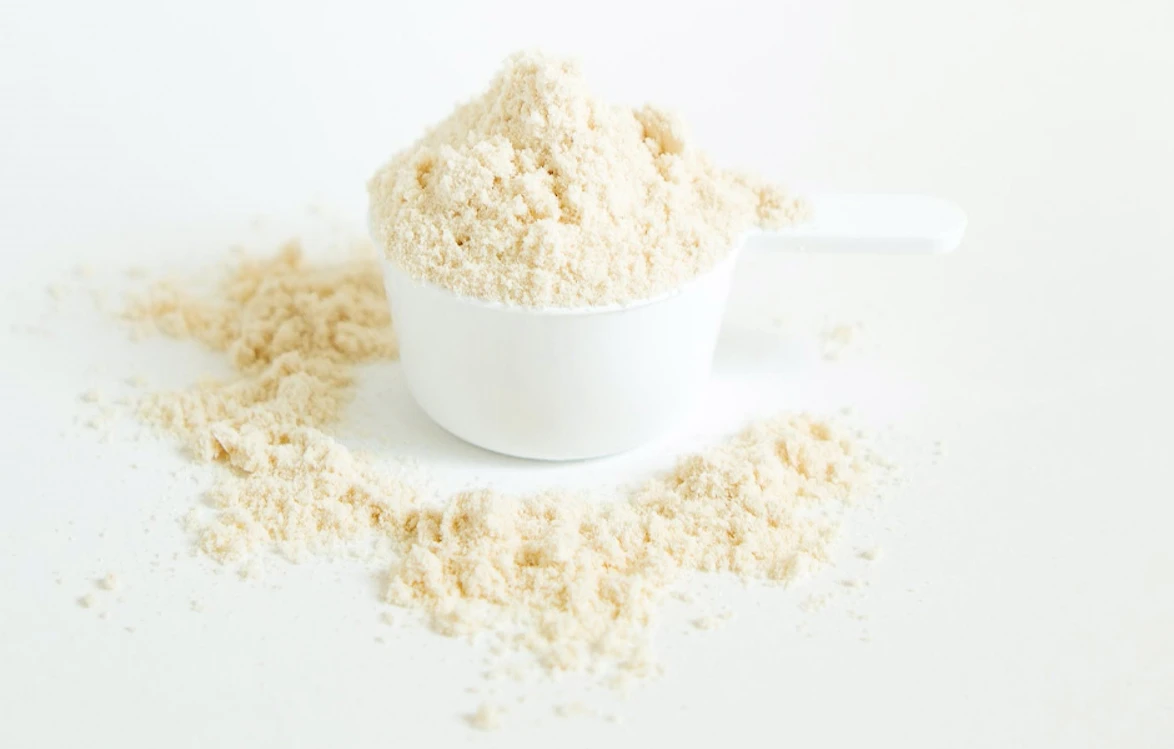Time to read: 5 min
Whey protein shakes: here's how they're made
More and more people are making it a habit to supplement their daily diet with extra protein, often in the form of protein powder.
At Orangefit, we're crazy about plant-based products. That's why we only use plant-based ingredients, such as pea protein, for our plant-based protein powder. However, the most well-known form, even though we're seeing a shift towards plant-based options, is still whey protein powder.
But what exactly is whey? How is it made? Where does it come from? What impact does it have on the environment? And how is plant-based protein powder made? We'll tell you all about it below!
What is whey protein exactly?
Most people know that whey is a form of dairy. But what's less known is that whey used to be considered a byproduct of the dairy industry.
Whey is a liquid that is formed as a residual product during cheese making. After adding rennet to the milk, whey and curd are the remaining components. Whey naturally has a yellowish-green color and a slightly acidic taste.
Originally, whey was dumped into rivers or on land as waste, which was quite polluting for the environment. (1) Then, it was used as feed for pigs for a while. The pigs were found to grow extra quickly and their meat became tender. This eventually inspired the transition from waste to useful product: whey powder as a supplement to the human diet was born.
Whey protein can be found in three forms: concentrate, isolate, and hydrolysate.
- Whey concentrate - approximately 29-89% protein, lactose, and fat, rich in nutrients;
- Whey isolate - 90% protein or more, less lactose and fat, fewer nutrients;
- Whey hydrolysate - hydrolyzed whey. This is absorbed more quickly by your body but causes a much higher insulin spike.
Whey concentrate is the most common variant because it is cheaper and contains more nutrients.
The production process of whey: how is whey powder made?
So, whey is a byproduct of cheese production. After separating the curds and whey, the whey is acidified. This causes the whey proteins to clump together, which can then be separated from the rest of the whey.
To obtain whey powder, the clumps are flattened. Whey protein, unlike the acidic whey, has a bitter taste, so it is almost always sweetened with flavorings and sweeteners before being sold.
The ecological footprint of whey powder
As mentioned, whey is a byproduct of the cheese industry. However, because whey protein powder has become commercially lucrative, there are now factories that focus entirely on whey production.
The dairy industry has recently come under fire due to its negative impact on the environment. Various studies have shown that dairy has a similar climate impact as meat and is among the top 3 most polluting foods. (3), (4)
Butter and cheese, including whey, have a particularly significant impact. This negative effect of the dairy industry on the climate is mainly due to the amount of methane emitted by cows.
Is there a more sustainable alternative to whey protein?
Whey is a high-quality protein source with a complete amino acid profile and may have some health-promoting properties. However, a significant portion of people do not benefit from these advantages due to lactose intolerance, and there may also be some potential long-term adverse effects of using whey protein. There have been numerous studies published on the health benefits and risks with conflicting outcomes. Therefore, more accurate (and independent) research is needed to determine the actual pros and cons.
The reason why more and more people are opting for plant-based proteins and alternatives is due to the highly unethical aspects and the enormous ecological footprint of animal protein.
Are you also considering switching to plant-based proteins? Fortunately, you won't have to miss out on anything. An excellent alternative to whey powder is pea protein, such as our own Orangefit Protein: a high-quality plant-based protein with a complete amino acid profile as well.
Research shows that pea protein has the same effect on muscle building as whey protein, for example. (6)
The major advantage of plant-based proteins? They have a much smaller environmental impact, are 100% animal-friendly, and come with their own health benefits as well. (7), (8), (9)
An additional benefit: pea protein is hypoallergenic, meaning that even if you have lactose or cow's milk allergies, you can use it without worries.
How is pea protein made?
Pea protein has a complete amino acid profile and compared to other plant-based protein sources, it has a pleasant taste and texture. That's why we at Fit Green Protein gladly choose pea protein. If you want to know how pea protein is made, read on.
-
It starts with whole peas, which are sieved and hulled.
-
The hulled peas are ground and placed in a water solution.
-
During this process, the proteins dissolve, while the fibers and starch do not.
-
The dissolved fraction is separated from the undissolved fraction (decantering).
-
The protein solution is further concentrated.
-
Finally, the solution is dried using spray drying.
Spray drying is a method of forming powder from a solution. The concentrated solution is passed through a sprayer and then sprayed into a lightly heated tower. The small droplets dry in the warm air, leaving behind the dry substance. It is then ground and sieved once again.
And voila, the pea protein is "ready." It's that easy!
Do you have any questions?
If you have any further questions about how whey protein or plant-based proteins are made, give us a call Monday to Friday from 08:30 to 17:00 or send an email to hallo@orangefit.nl. We're here to help!
